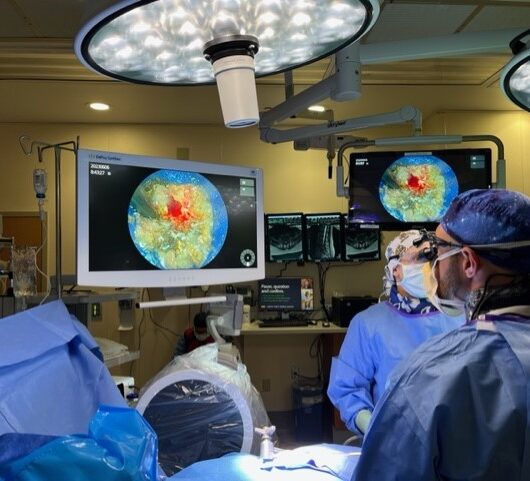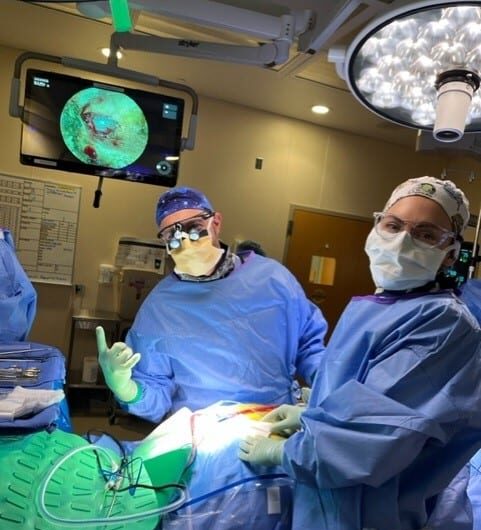 People in Colorado and the western United States who suffer from lower back pain and fail to find relief with conservative treatment may be candidates for a minimally invasive spine surgery using the new FDA-approved TELIGEN™ System. Wissam Asfahani, MD, FAANS, in Denver is one of the only neurosurgeons in the United States to be trained in the TELIGEN™ System. Available for patients at Parker Adventist Hospital, the TELIGEN™ System enhances minimally invasive lumbar spine surgery by improving visibility and standardizing operating procedures while reducing potential operating time and exposure to radiation.
People in Colorado and the western United States who suffer from lower back pain and fail to find relief with conservative treatment may be candidates for a minimally invasive spine surgery using the new FDA-approved TELIGEN™ System. Wissam Asfahani, MD, FAANS, in Denver is one of the only neurosurgeons in the United States to be trained in the TELIGEN™ System. Available for patients at Parker Adventist Hospital, the TELIGEN™ System enhances minimally invasive lumbar spine surgery by improving visibility and standardizing operating procedures while reducing potential operating time and exposure to radiation.
“The best thing about the TELIGEN™ System is that it takes minimally invasive spine surgery to the next level by improving visibility through a much smaller incision,” Asfahani said. “We can see more even though the incision is smaller. This provides for increased safety with the procedure, quicker recovery time, and a better overall experience for patients.”
When compared to traditional minimally invasive transforaminal lumbar interbody fusion (TLIF), the TELIGEN™ System has been shown to provide up to a 47% reduction in fluoroscopy (radiation exposure) and may reduce procedure time by 11%.
How does the TELIGEN™ System improve on TLIF surgery?
TLIF is one of the surgical approaches that may be recommended for people with persistent, unresolved lower back pain. TLIF surgery has favorable spinal fusion rates2. However, studies show that open TLIF carries an increased risk of complications6, greater damage to the soft tissue2, slower recovery time7,8, and mixed results for long-term outcomes that include greater back pain and disability8.
Minimally invasive spinal surgery options have reduced the potential side effects and risks of open TLIF but are not without their downsides, including:
- Lack of consistent visualization during the procedure9
- A steep learning curve for surgeons9
- Occupational hazards to surgeons due to neck and back position while conducting the surgery10,11
The TELIGEN™ System reduces or eliminates these issues.
“It’s not an overly complicated system to learn, and the improved visualization capabilities make the entire surgical process safer and more efficient,” says Asfahani, who has helped train surgeons on the new MIS technology.
How does the TELIGEN™ System improve visibility for TLIF surgery?
With traditional minimally invasive spine and TLIF surgeries, surgeons have to use a microscope for visualization. This limits the surgeon’s view and can impact accuracy and safety.
With the TELIGEN™ System, a microscope and enhanced lighting are part of the technology, so not separate like with traditional minimally invasive TLIF surgery. Here’s a comparison of the TELIGEN™ System verses traditional minimally invasive TLIF surgery with a 24 mm port microscope:
| TELIGEN™ System | Traditional Minimally Invasive TLIF Surgery | |
| View of surgical site | Unobstructed view of the surgical site through the digitally enabled TELIGEN VUE™ Camera | Obstructed view of surgical site due to the separate microscope |
| Visualization | Hands-free, allowing the surgeon to use both hands for the surgical instruments; offers up to 3 times more visualization compared to the traditional 24 mm port microscope 12 | Requires manual manipulation of microscope, which limits the surgeon to one hand for surgical instruments |
| Views | Multidirectional and expanded | Often limited and one or two directional |
| Image manipulation | Can be done according to the surgeon’s preferences | Not possible unless additional technology is utilized |
What patients may benefit from the TELIGEN™ System?
 The new technology can be used on most posterior lumbar approaches to spine surgery involving the L1-S1 area of the spine. While the majority of adults will experience back pain at some point in their lifetime, a small percentage of people with degenerative disc disease, spondylolisthesis, spinal stenosis, or persistent lower back pain may need spinal surgery if they fail to find relief with more conservative treatment.
The new technology can be used on most posterior lumbar approaches to spine surgery involving the L1-S1 area of the spine. While the majority of adults will experience back pain at some point in their lifetime, a small percentage of people with degenerative disc disease, spondylolisthesis, spinal stenosis, or persistent lower back pain may need spinal surgery if they fail to find relief with more conservative treatment.
When was the first surgery with the TELIGEN™ System in Colorado?
Asfahani conducted his first surgery using the TELIGEN™ System at Parker Adventist Hospital in June 2023. He anticipates using the system for TLIF surgeries and decompression spinal surgeries whenever possible.
“Every patient and situation are different, but I envision using the TELIGEN™ System regularly,” he said.
There are only 6 TELIGEN™ Systems in the country with Parker Adventist Hospital being the only location in the western United States.
Dr. Wissam Asfahani, a spine surgeon and neurosurgeon in Parker, Colorado, is board certified by the American Board of Neurological Surgery. He specializes in treating all facets of neurosurgery including, but not limited to, degenerative and traumatic disorders of the spine and brain, as well as brain and spinal cord tumors, and traumatic brain injuries. Dr. Asfahani receives compensation from DePuy Synthes for training other surgeons on use of the TELIGEN system; he does not receive any other type of compensation for use of this equipment.
References:
- Wu A, March L, Zheng X, et al. Global low back pain prevalence and years lived with disability from 1990 to 2017: estimates from the Global Burden of Disease Study 2017. Ann Transl Med. 2020;8(6):299- 299. doi:10.21037/atm.2020.02.175
- Mobbs RJ, Phan K, Malham G, Seex K, Rao PJ. Lumbar interbody fusion: techniques, indications and comparison of interbody fusion options including PLIF, TLIF, MI-TLIF, OLIF/ATP, LLIF and ALIF. J Spine Surg. 2015;1(1):2-18. doi:10.3978/j.issn.2414-469X.2015.10.05
- Parker SL, Adogwa O, Witham TF, Aaronson OS, Cheng J, McGirt MJ. Post-operative infection after minimally invasive versus open transforaminal lumbar interbody fusion (TLIF): literature review and cost analysis. Minim Invasive Neurosurg. Feb 2011;54(1):33-7. doi:10.1055/s-0030-1269904
- Tan JH, Liu G, Ng R, Kumar N, Wong HK, Liu G. Is MIS-TLIF superior to open TLIF in obese patients?: A systematic review and meta-analysis. Eur Spine J. Aug 2018;27(8):1877-1886. doi:10.1007/s00586- 018-5630-0
- Xie Q, Zhang J, Lu F, Wu H, Chen Z, Jian F. Minimally invasive versus open Transforaminal lumbar Interbody fusion in obese patients: a meta-analysis. BMC Musculosk .2018
- Othman YA, Alhammoud A, Aldahamsheh O, Vaishnav AS, Gang CH, Qureshi SA. Minimally Invasive Spine Lumbar Surgery in Obese Patients: A Systematic Review and Meta-Analysis. Hss j. Jul 2020;16(2):168-176. doi:10.1007/s11420-019-09735-6
- Hockley A, Ge D, Vasquez-Montes D, et al. Minimally Invasive Versus Open Transforaminal Lumbar Interbody Fusion Surgery: An Analysis of Opioids, Nonopioid Analgesics, and Perioperative Characteristics. Global Spine J. Sep 2019;9(6):624-629. doi:10.1177/2192568218822320
- Xie L, Wu WJ, Liang Y. Comparison between Minimally Invasive Transforaminal Lumbar Interbody Fusion and Conventional Open Transforaminal Lumbar Interbody Fusion: An Updated Meta-analysis. Chin Med J (Engl). Aug 20 2016;129(16):1969-86. doi:10.4103/0366- 6999.187847
- Simpson AK, Lightsey HM 4th, Xiong GX, Crawford AM, Minamide A, Schoenfeld AJ. Spinal endoscopy: evidence, techniques, global trends, and future projections. Spine J. 2022;22(1):64-74. doi:10.1016/j. spinee.2021.07.004
- Stucky CH, Cromwell KD, Voss RK, et al. Surgeon symptoms, strain, and selections: Systematic review and meta-analysis of surgical ergonomics. Ann Med Surg (Lond). Mar 2018;27:1-8. doi:10.1016/j. amsu.2017.12.013
- Naresh-Babu J, Arun-Kumar V, Raju DGS. Surgeon’s Neck Posture during Spine Surgeries: “The Unrecognised Potential Occupational Hazard”. Indian journal of orthopaedics. Nov-Dec 2019;53(6):758-762. doi:10.4103/ortho.IJOrtho_677_18
- DePuy Synthes. Letter to File – Teligen Geometrically Expanded Visualization. December 28, 2021. DePuy Quality Management System, Adaptive#103862153.



